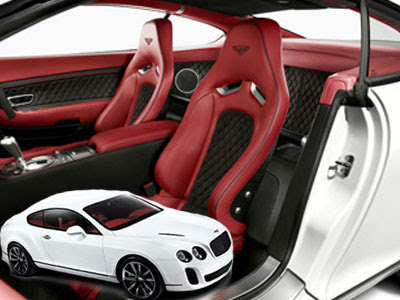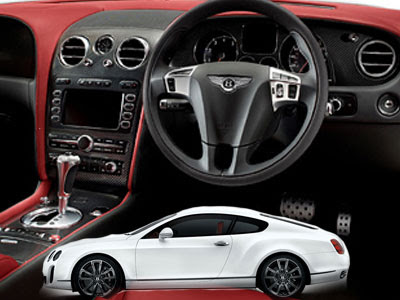2010 Bentley Continental Supersports Car
The
Bentley Continental Supersports is the first Bentley model to be
designed with some thought given to the environment. Bentleys will never be the most economical or environmentally friendly of vehicles but at least they're recognizing the fact that times are changing.The
Continental Supersports began as an 'under the radar' project exploring the possibilities of weight reduction on the
Continental GT but with more power and torque.The Bentley Continental
Supersports is the fastest and most powerful Bentley ever. It is the extreme Bentley, a muscular two-seater that delivers supercar performance and a highly focused driving experience. The Bentley Continental Supersports is also the first Bentley capable of running on both petrol (gasoline) and biofuel, pioneering the use of
FlexFuel technology in the luxury sector. This represents stage one of the company's commitment to make its complete model range compatible with renewable fuels by 2012. Available worldwide from autumn 2009, the Bentley Continental Supersports will be FlexFuel compatible in the majority of markets from launch with North American cars offering the capability by summer 2010, following regulatory approval

2010 Bentley Continental Supersports Car
A largely experimental process crystallised over a period of 24 months into an official new car programme, driven by the passion and enthusiasm of a small group of Bentley engineers and designers.
Powering the Continental Supersports is a
twin-turbocharged,
6.0 litre W12 engine which is capable of running on either regular gasoline or E85 biofuel, or a mixture of both. Despite the flex fuel capability the Supersports engine produces a massive 621 horsepower @ 6,000 rpm and 800Nm (590 lb-ft) of torque @ 1,700 rpm - 5,600 rpm. This means the Continental Supersports can reach 60 mph in just 3.7 seconds, 100 mph in 8.9 seconds, and top out at 204 mph.

2010 Bentley Continental Supersports Car
The Continental Supersports is fitted with Bentley's carbon-ceramic brakes as standard – the largest and most powerful ever fitted to a production car. The large diameter (420 mm front, 356 mm rear), lightweight discs and eight-piston calipers offer fade-resistant braking performance with minimal disc distortion under high thermal conditions. Overall, the engineering team have achieved a weight reduction of 110 kg (243 lb) compared with the Continental GT Speed.
The evolution of the Bentley Continental Supersports' design is very much a case of 'form following function' with new purposeful sculptural forms signalling the engineering changes beneath the skin.

2010 Bentley Continental Supersports Car
The Continental Supersports agility is further sharpened by the 40:60 rear-biased torque split for the all-wheel drive system, a wider rear track, bespoke lightweight 20-inch alloy wheels and a unique electronic stability program.Cosmetic changes to the Bentley Continental Supersports have arisen due to the new powertrain.
The 'Supersports' name is inspired by the original two-seater 3-litre Supersports model introduced in 1925, itself an evolution of the 3-litre Speed. The lightweight, 85 bhp Supersports was the first production Bentley to reach 100 mph and was also renowned for the application of Le Mans-winning race technology.

2010 Bentley Continental Supersports Car
Commenting on the new Supersports model, Dr. Franz-Josef Paefgen, Bentley's Chairman and Chief Executive said: "The Bentley Continental Supersports reflects the passion and enthusiasm of Bentley's engineers and
designers. This is the fastest, most extreme Bentley ever, dramatically styled to underline its
supercar character. Importantly, it also pioneers the use of FlexFuel technology in the luxury sector."





















